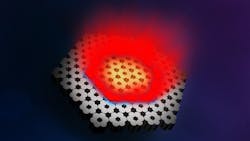VCSELs acting as single laser boosts medical, communications applications
Coherently combining an array of vertical cavity surface-emitting lasers (VCSELs) into a single laser could lead to very compact high-power, high-brightness laser sources, opening up new applications. While only “the size of a grain of sand,” the recently developed laser network has already been proven highly effective and shows promise for applications such as medical devices.
Researchers from Technion-Israel Institute of Technology (Haifa, Israel), in conjunction with teams from Julius-Maximilians-Universität Würzburg in Germany and the Cluster of Excellence, ct.qmat–Complexity and Topology in Quantum Matter (a joint research collaboration between Julius-Maximilians-Universität Würzburg and Technische Universität Dresden, also in Germany), employed a geometrical arrangement of VCSELs on a chip that forces the flow in a specific path, known as a photonic topological insulator platform. Described by researchers, “topological insulators are revolutionary quantum materials that insulate on the inside but conduct electricity on their surface without loss.”1
To date, scientists’ efforts to enhance the power emitted by VCSELs by combining numerous units and forcing them to act as a single coherent laser have been generally unsuccessful.
The breakthrough
Here, the researchers forced topological insulator lasers, which are “arrays of semiconductor lasers that exploit fundamental features of topology to make all emitters act as a single coherent laser,” to lock within a planar chip. This prompted light from each tiny laser to coherently synch with its neighbor, resulting in emitted light that is coherent across the surface of that chip, and emitted perpendicular to the chip (see figure). According to the researchers, their “experiments exemplify the power of topological transport of light. The light spends most of its time oscillating vertically, but the small in-plane coupling is sufficient to force the array of individual emitters to act as a single laser.”
“The topological principle of this [combined] laser can generally work for all wavelengths and thus a range of materials,” says Sebastian Klembt, project leader and a professor at the University of Würzburg, where he is working on light-matter interaction and topological photonics within the ct.qmat Cluster of Excellence.
Previously, a group at Technion-Israel was able to exhibit the first photonic topological insulator—light traveled around the edges of a 2D array of waveguides and were not affected by defects or disorder. The same group also was able to use the properties of photonic topological insulators to force a number of microring lasers to lock together and act as a single laser. However, the researchers note, the “system still had a major bottleneck: the light was circulating in the photonic chip confined to the same plane used for extracting the light out.” The team’s new developments avoid this.
“Back in 2015, when we started to work on topological insulator lasers, nobody believed it was possible because the topological concepts known at that time were limited to systems that do not, in fact cannot, have gain,” says Mordechai Segev, a professor who led that work at Technion. “But all lasers require gain. So topological insulator lasers stood against everything known at that time. We were searching for something that was considered impossible. And now we have made a significant step toward real technology that has many applications.”
Most notably, those applications include medical devices and communications systems.
REFERENCE
1. A. Dikopoltsev et al., Science, 373, 6562, 1514–1517 (Sep. 24, 2021).
About the Author
Justine Murphy
Multimedia Director, Digital Infrastructure
Justine Murphy is the multimedia director for Endeavor Business Media's Digital Infrastructure Group. She is a multiple award-winning writer and editor with more 20 years of experience in newspaper publishing as well as public relations, marketing, and communications. For nearly 10 years, she has covered all facets of the optics and photonics industry as an editor, writer, web news anchor, and podcast host for an internationally reaching magazine publishing company. Her work has earned accolades from the New England Press Association as well as the SIIA/Jesse H. Neal Awards. She received a B.A. from the Massachusetts College of Liberal Arts.

